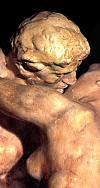

The Maclaren collection: towards a scientific catalog (1)
The donation of ca. 50 Rodin plasters to the MacLaren Art
Center in Barrie, Canada, publicly announced in April 2001, has raised
some intensely discussed questions about their provenance, quality and
art-historical status.
 As we found out, this collection had been put together by the
Gruppo Mondiale Est, a private cultural organization based in Italy, who had
acquired a large number of items originating from the settlement of the
former Rudier Foundry. Although this origin was unquestioned, scholars and art
critics were unsure about the precise status and significance of these plasters,
since the majority of the collection consists of so called foundry plasters,
that were either sent in to the foundry by Rodin himself, or were duplicated
from such examples by the foundry craftsmen, in order to prevent damage to
first-generation plasters that might occur during the casting process.
As we found out, this collection had been put together by the
Gruppo Mondiale Est, a private cultural organization based in Italy, who had
acquired a large number of items originating from the settlement of the
former Rudier Foundry. Although this origin was unquestioned, scholars and art
critics were unsure about the precise status and significance of these plasters,
since the majority of the collection consists of so called foundry plasters,
that were either sent in to the foundry by Rodin himself, or were duplicated
from such examples by the foundry craftsmen, in order to prevent damage to
first-generation plasters that might occur during the casting process.
As a matter of fact, some of the donated plasters look quite
battered and discolored, due to the use of solving agents in the creation of
moulds, whereas others show sharp detail and good surface quality, as can be
expected from studio or exhibition plasters.